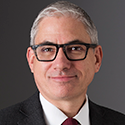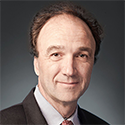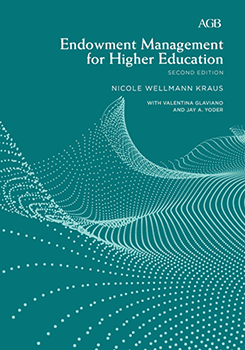
Aired: May 17, 2022
AGB recently released the second edition of Endowment Management for Higher Education. Since the first edition was published in 2017, the COVID-19 pandemic provided a quick stress test for endowments. In this podcast, AGB’s Executive Director of Philanthropic Governance David Bass discusses with Nikki Kraus, coauthor of the publication and Chief Client Officer of Strategic Investment Group, and Horacio Valeiras, Chief Executive Officer of Frontier Global Partners and a member of the Virginia Tech Board of Visitors, how the environment in which investment committees operate today is different from the prepandemic era and some of the most important lessons learned in recent years.
Podcast Transcript
Introduction:
Welcome to the Trusteeship podcast from AGB, the Association of Governing Boards. We cover everything higher education leaders need to know about the challenges facing our nation’s colleges and universities.
More important, we provide the facts and insight you need to solve those challenges and to be the storytellers and advocates higher education needs.
Today, we’re talking about endowments. Higher education endowments are part of the funding model for many institutions and they exist to help support the advancement of the institution’s mission.
AGB recently released a second edition of Endowment Management for Higher Education. In this podcast, AGB’s executive director of philanthropic governance David Bass talks with Nikki Krauss, Chief Client Officer of Strategic Investment Group and co-author of the updated endowments publication, and Horacio Valerias, Chief Executive Officer of Frontier Global Partners and a member of the Virginia Tech Board of Visitors, and a former member of AGB’s board of directors.
David:
Horacio and Nikki, thank you very much for joining us today. Nikki, thank you for all of your thoughtful work on the original and now the updated edition of Endowment Management for Higher Education. It’s a tremendously valuable resource for investment committees as well as institution and foundation investment and finance staff. Horacio, thanks for your service as a member of AGB’s Board of Directors and your service as a member of three higher education governing boards.
The last version of Endowment Management for Higher Education was published back in 2017. Since that time, the COVID-19 pandemic provided a quick stress test for endowments. That was happily followed by a historic period of growth. The pandemic also subjected college and university business models to genuine and ongoing stress. To start, I’d like to explore how the environment in which investment committees operate today is different from the pre-pandemic era and some of the most important lessons we’ve learned in recent years. Horacio, will you start us off by sharing your perspective as a member of governing boards and investment committees?
Horacio
Well, thank you, David, and thank you for having us on this podcast. I think the pandemic has created an environment in which it’s allowed us to test and stress test some of the concepts that we always thought were essential for endowment management.
The world hasn’t changed, except it’s given us a laboratory in which we can think about what things worked and what things didn’t work, and what adjustments we need to adopt going forward, in terms of how we manage endowment portfolios.
It really became very apparent that you needed a strong investment policy statement with strong processes and procedures, with a strong delineation of responsibilities, since many committees weren’t able to meet during this time, and if they met, they met on Zoom, which was very different from meeting in person.
It also focused the different pools that can be managed within an endowment or within the concept of an endowment. There’s the long-term endowment, then many universities and colleges have operating funds that are invested in an endowment-like pool. The liquidity issues of the endowment came to the forefront.
And most of all, it really, really got us to focus on risk. What were the risks that we were taking in the endowment?
David:
So the pandemic has provided us with a laboratory. Nikki, what have you seen in the various laboratories into which you have insight as an advisor to college and university endowments?
Nikki:
I would add two things. I think the importance of solid leadership was critical during this period of time. And there’s been a significant movement, which we support greatly, to add more diversity to boards and investment committees. And that is something we should all try to do.
The only potential downside of adding diversity is it could mean that there is a lot of turnover and you lose the stability in leadership that was so critical during the COVID crisis and is critical in times of stress.
Almost every board or committee seems to have one long-standing member that in a time of crisis, the group turns to for that solid leadership. So, that would be one of the things that, for those groups who had it, it was critically important. And for those groups who didn’t have it, it was something they regretted that they didn’t have. So, I think that was one other thing.
And in addition to what Horacio mentioned, I will just amplify the importance of enterprise risk. Enterprise risk is critical, because not every institution can take the same level of risk.
And we’ve been in a period of time, since 2009, where markets were very forgiving and a lot of committees got overconfident with their ability to withstand volatility in the investment portfolio. And then COVID hit and we found risk on the operating side, and on the investment side, and in some cases, organizations found, “Gosh, we didn’t have as many rainy day funds and, we don’t have the risk tolerance that we thought we had.”
David:
You bring up two things, Nikki, that might be worth exploring a little further. One, the qualifications and capacities needed in investment committees, and also a question about a pretty fundamental governance practice, which is term limits.
Nikki:
Yes, we added this in the new edition of the book, and added a grid, and I think everyone has to love the institution. You need at least one member who’s willing to ask a big picture question. You don’t ever want someone who is reluctant to speak up, even when they disagree, and you don’t want folks who think their voice is more important than everyone else’s, who speak over everyone else. That can be a very dangerous attribute.
It’s also important to make sure the group is aware of their requirements and they’re willing to fulfill those. So, attendance is critical, coming prepared, this element, again, of listening and engaging is critical. Also, critical is that they’re willing to undertake an orientation, which, interestingly, a lot of groups don’t do, and that’s one of the fundamental principles.
I think it’s great to have someone who’s been around for at least 10 years, to provide that institutional memory. And then as we talked about, it’s great to have newer members to bring fresh ideas. Having someone who’s been a CIO, in regards to another portfolio, is an amazing person to have on a committee. I think one attorney is a great person to have on a committee, a CEO or other business leader.
There was a lot of debate when we worked on the book about money management executives—are they good or are they bad? Some investment professionals can be amazing, especially in areas of alternative investments where they’re becoming more complicated and an increasingly large part of a portfolio, yet not all money management professionals are great members of committees, because some can be very type A, want to act quickly, only know their area of a market. So that can be a dangerous attribute also.
On term limits I understand why people like them. Yet on the flip side, what I’ve heard many, many times, when there’s a badly behaving member on an investment committee, a group will say, “I’m just going to wait for them to term out,” instead of actually dealing with that bad member and their bad behavior. So, that’s why I don’t love term limits, because I find that it’s a crutch to good leadership and dealing with a badly behaving member, but I know Horacio disagrees.
David:
I think that cues you up, Horacio. We’ll ask you to share, share your perspective on some governance practices, beyond those that Nikki indicated, that you would recommend for boards to ensure that they have the best possible investment committees. But why don’t you start by talking about how as a committee chair, you manage behavioral problems within the committee.
Horacio:
I think all that Nikki said is very important. As a committee chair, you need to—whenever there is a behavioral issue—you need to sit down with that person right away.
First of all, you should address it in your orientation. Nikki brought up the idea of getting everybody on the same page, and you need to address it at the orientation. If beyond the orientation, there’s still a behavioral issue, then you need to sit down with that person and be honest. Not every organization is for everybody. And not everybody, you know, fits in. And if they feel that their talents aren’t being used in the best way, then sometimes you need to part ways.
It happens in all, in all facets of life, boards, organizations, everywhere. But you need to deal with it right away, because what happens if you don’t deal with it is that it can basically create a rot within the organization, within the board, that can splinter groups.
We’ve seen it happen at many institutions. We’ve seen bad behavior, we’ve seen people not all talking with one voice, that are part of the board, which is also essential. And that’s also something you need to address in an orientation, that once a decision is made, everybody’s got to be behind it even if they weren’t before, that you allow time for discussion.
But in addition to that, the chair has to be very, very, observant of any conflicts that arise between board members and either the institution, the staff, or whatever. This is an area that is ripe for conflict, because most of the people in investment committees have links to investment people, they have links to, asset managers, they have links to, you know, whether it, you know, legal organizations, and so on.
It’s crucial that everybody understands what organization you have, what structure you have.
Whichever structure you have, you need to make sure everybody understands what that structure is. And so, I think the best committees work on a strategic and generative basis, and they don’t get into the day-to-day management of the endowment.
David:
Horacio, I want to follow up on one point you made. All boards should have an orientation for new board members. I believe orientation should be an ongoing process of board education. Is there a need for specific orientation for new members of investment committees, and what might that look like?
Horacio:
I believe so. I think that like every aspect of the board, there are nuances and things that are very specific to an investment committee, that are specific to endowment management, that are specific to the conflicts of an investment committee, that really, should be discussed on its own.
I think on an annual basis, it’s good to do a reminder, it’s good to invite existing board members and committee members to whatever orientation you have for new board members. I find that some of them like to show up, and, and it’s a great chance not only for the chair and the board chair to tell their side of the story, along with the staff, but it’s also some input from some existing board members, which can also be useful to new board members.
Nikki:
I’d love to add to that, because I, I think this idea of as fiduciaries, what are the things the investment committee should cover once a year? In addition, I’d add reviewing the investment policy statement once a year, you mentioned this earlier, Horacio, is a great practice. And it doesn’t mean you’ll change it every year, but it reminds you of the rules, the responsibilities, what the objectives are, what the benchmarks are.
Reviewing the asset allocation also, again, not with an idea to change it every year, but to be confirming that it makes sense given the risk profile, it also has a great add-on benefit if you welcomed any new members of the committee over that year, you’re engaging them in confirming this really critical decision, relative to the performance of the endowment.
Reviewing the fees paid once a year, having the CFO talk about the enterprise risk perspectives, how is enrollment trending, debt levels, expected capital projects, discount rates, anything that would affect the ability to take risk in the portfolio.
I’d also recommend legal counsel review any obligations the group has as fiduciaries once a year. Doing an assessment of a committee. And that doesn’t even have to be extremely formal, but this idea of what’s happening that’s working, what perhaps, could we be doing better? Sitting down with the CIO, whether internal or external, to say, “We think this is going great and we’d love to refine these elements of our relationship.”
A joint meeting between finance and investment committees once a year is a great idea. We talked earlier about stress tests, and that’s become a more common practice. And then, I also think having a longer meeting once a year that is more strategic, instead of that hour, hour and a half meeting, is a great thing to do.
Horacio:
I can’t stress enough, I think Nikki makes a great point, particularly for public universities, where you have a separate foundation many times, and a governing board.
The communication between the investment committee and the endowment board, the foundation board, and the governing board of the university is crucial.
So, the communication, whether it goes through the staff, whether it goes through the committee chairs, whether it goes through the board chairs, is really important, because what you find is a lot of times, the mission is not necessarily totally aligned unless that communication is there. And, and I think that’s essential if the foundation, if the endowment, is to meet the long-term strategic goals of the university.
David:
Yes.
Nikki:
Yes.
David:
One of the big changes we’ve seen in recent years is the steady growth in the numbers of institutions that are integrating some of the ESG, environmental, social, or governance factors, into their fundamental investment analyses, and are exploring ways to align their investment practices with institutional missions and values.
Now, that would include a commitment to diversity and inclusivity. So, Nikki, I want to ask you, what sort of changes have you seen, working with your clients, and could you touch on some of the changes you made in the book, speaking directly to ESG investing.
Nikki:
Yes. We have a new chapter written by my colleague, Valentina Glaviano, and I think it harkens back to AGB’s primary principles of getting the right people, focusing on the right thing, and engaging in the right way. This is a critical decision for any organization to go through, and to get the right people is critical.
So, not only having board members, but having faculty, having students, having donors. Having someone from an investment perspective who understands, “Can it be implemented in the way that the group comes up with,” is actually critically important to get that right.
I should also start by saying there isn’t one way to do this. And the more we talk with organizations and look at the various processes, there isn’t one way. So, what we tried to do in the book is outline a process, and you’ll find that two institutions, seemingly who have similar objectives at the beginning, might wind up in very different places after they go through this process.
Additionally, you have to then answer a lot of questions. How do I align the portfolio, with the objectives? What are the objectives that are critical to us? And, and determining how to do that in the portfolio.
And then a couple other points, no matter what, documenting what you’ve done and what you’ve come up with, and why, I think is critical. Monitoring the situation, looking at how much things have changed, even over the last couple of years, is evidence of why you have to continue to monitor.
And then, finally, you have to be committed to revisit this. Again, as we learn more, as there’s additional opportunities to improve your process, I think this becomes a process, not one particular series of questions that you answer and then you put it on the shelf.
Horacio:
Right. And I would add that process is crucial because there is a lot of pressure, whatever the latest fad is on. In this space, and you’ll hear it from students, you’ll hear it from faculty, you’ll hear it from other board members. And you need to make sure that whatever you do is aligned with the mission of your institution.
And keep in mind that any time you make a trade-off, there is usually another trade-off that you have to make. If you think about some of the decisions that have been made historically about what not to invest in, that has, at times, cost in terms of return.
David:
Horacio, you were talking about mission alignment and how critical that is in ESG decision-making, that’s obviously critical in a lot of ways. One of the fundamental principles of trusteeship is that boards should focus on what matters most to the long-term institution sustainability and vitality. Horacio, how does that guide you in your work as a leader and member of investment committees?
Horacio:
Well, that, I think it’s crucial, because endowment, obviously, you need to provide for intergenerational equity—think about what you’re spending now versus what you’re spending in the future. Your return now versus your long-term return in the future.
It really comes down to you start with what is the mission of the institution? And so, you need to define that correctly. Is our mission social change or is it to educate a diverse pool of students so they can be great citizens in the world? Different institutions are going to end up in different places.
But, once you define that then you have to make sure that everything you do, all the practices of the investment committee and the board are aligned with whatever that mission is. And everybody has to know what that mission is. A strategic plan is crucial to make sure that you’re all rowing in the same direction.
And Nikki, in the book, talks about the importance of having a strategic plan and having that guide the decisions that you make. If your organization doesn’t have one, go back and start there, because you really need to start at the beginning. You need to have the fundamentals in place, in order to be able to execute on your long-term, institutional sustainability and vitality.
Most of us are in the education world. Our job is to prepare people to be good citizens in the world. So you need to make sure that that strategic plan, plan reflects that.
David:
I want to, want to wrap this up by asking each of you one simple question. If you were going to sit down with a new investment committee chair, or somebody who has been slated to assume leadership of an investment committee chair, what’s the most important piece of advice you’d give? I’ll let Nikki start and then give Horacio the last word.
Nikki:
I often find that you get people’s attention by focusing on what are the most expensive mistakes and how do you avoid them? I would think that the biggest danger on an investment committee is changing strategy at the wrong time.
So, to harken back to what Horacio just said, making sure everyone is clear about the strategy, and that you’ve communicated it across, you’ve done everything that you can so you have the right investment strategy and that you make sure that you don’t change that at the worst possible time.
In addition, I do think today there is so much pressure to do something quickly for ESG, or, or diversity, equity, and inclusion efforts, that there’s a lot of pressure to move quickly. And I think if you move too quickly, you don’t get the broad group together, you don’t really study the potential issues and the optimal way to do it, I think that can be an area where folks could make some mistakes in today’s environment.
And then the other critical thing is this idea of institutional memory that we keep talking about, but it’s so critically important. So, I would talk to the new committee chair about making sure they have a good succession plan, and making sure they look at that mix of skills, and are identifying that you, David, perhaps, would be a great committee member to add, that I want to keep you in the wings for–to potentially be coming on to my committee, and how do I plan so it’s this very smooth process?
It was something that was surprising to me in the last five years, since we worked on the other book, that I’m now seeing new members on boards coming in as chair as an investment committee, and then not having any orientation.
So, you stacked a whole bunch of mistakes on top of one another. And so, you know, making sure, again, that that communication and governance process is good, that you get the right people, you focus on the right things, and you do so in the right way.
Horacio:
I would add that, there’s a tendency to respond to whatever is going on. As you as the chair of either the board or the investment committee need to keep your eye on the long term, keep your eye on the mission, and make sure that everything that you do within a meeting, within a discussion really gets back to that, because there is a tendency for people to focus on quarterly results. There’s a tendency for people to focus on whatever the latest, risk is. There is a tendency for people to not think about the long term.
If you’re talking about debt levels of the institution, okay, what are the projections? Not what it is today, but what are the projections five years out? What are the projections ten years out? Because that’s what you can impact. You can’t impact where you are today, and as a committee chair, as a board chair, you need to bring the entire board and the committee along to thinking about those longer-term issues.
David:
I think this is a great place to wrap up. Thank you both for an insightful conversation. I’ll offer one final piece of advice for investment committee and other board members. Go to AGB.org, download a copy of Endowment Management for Higher Education where you can read more about many of the topics that Nikki and Horacio addressed today, along with practical guidance and insights in all facets of endowment management. On our website, you can also find other valuable resources, including AGB’s Principles of Trusteeship, the AGB Board of Directors’ statement on justice, equity, and inclusion, and our online, on demand, new board member orientation. Thank you all.
Speakers

David Bass serves as AGB’s Executive Director for Philanthropic Governance, providing thought leadership on board governance and leadership best practices that relate to philanthropy in higher education. He oversees the development of programs and resources supporting institutionally related foundation boards, institutional governing boards, and others senior staff and volunteer leaders of higher education fundraising and stewardship. David previously served as AGB’s director of foundation programs and research.

Nikki Kraus, CFA, is the Chief Client Officer of Strategic Investment Group. She is responsible for developing and optimizing client relationships and driving the firm’s marketing strategy. She also serves as a member of Strategic’s Board of Managers. She has 27 years of experience in the outsourced chief investment officer industry having most recently served as Director of Institutional Business at Hirtle, Callaghan & Co. Nikki is the coauthor of Endowment Management for Higher Education, a publication released by AGB, the latest edition of which was published in February 2022.

Horacio Valeiras is the Chief Executive Officer of Frontier Global Partners. A former chairman of the Virginia Tech Foundation Board, he is a member of the Board of Visitors of Virginia Tech and also serves on the boards of directors for the San Diego Foundation, the Scripps Research Institute, and InHand Electronics. He is a former member of the Board of Directors of AGB.




